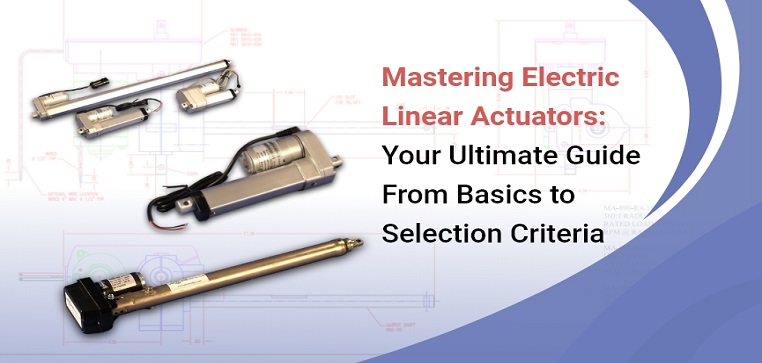
Electric linear actuators offer motion to industrial machines, automation equipment, robots, and more. They have evolved and advanced over the years in terms of their versatility, efficiency, precision, and reliability. These powerful yet compact devices transform electrical energy into controlled mechanical movement. This makes them applicable across industries such as robotics, manufacturing, healthcare, and more. With a focus on sustainability, electric actuators can be designed to be energy-efficient and are sustainable alternatives compared to hydraulic or pneumatic actuators. Based on your application, choosing the right actuator in terms of size, configuration, and more is important. This post offers useful information about electric linear actuators, their working, and guidelines for selecting the right one. So, stay tuned.
Working Principle of Electric Linear Actuators
The basic working principle of electric linear actuators is converting the rotary motion into a linear one. This conversion of motion is done with the help of a gearbox and a lead screw. These are the two most important electric linear actuator parts. As the screw starts rotating, it drives the nut along with its thread. This causes linear motion, which can actuate various mechanisms, such as opening and closing a valve, adjusting the position of a device, or lifting or lowering a load. The speed and direction of the linear motion can be controlled using the motor. This makes these actuators versatile and suitable for a wide range of applications. Get a detailed overview of electric linear actuator design and working here.
Types of Electric Linear Actuators
Electric linear actuators are available in different types, each with different strengths. The common types are as follows.
- As the name implies, screw-driven actuators utilize a screw mechanism for the conversion of rotary motion into linear motion. They are ideal for applications where high precision and force is paramount.
- Belt-driven actuators transmit motion using a belt and pulley system. They are preferred for applications demanding high speed and smooth operation.
- Linear motor actuators use a magnetized shaft and a stationary coil to convert electrical energy into linear motion. They offer high-speed and precise positioning capabilities.
- Piezoelectric actuators use the piezoelectric effect to generate linear motion. Due to their high resolution and fast response, these actuators are used in nanotechnology and precision positioning applications.
Benefits of Electric Linear Actuators
An electric linear actuator offers speed, precision, and control over the motion-related aspects of your system. Here are some pros of electric linear actuators.
- Electric linear actuators can operate efficiently in high-pressure applications, which is common in most industrial processes.
- The life-cycle cost of these actuators is comparatively lesser than other actuators.
- They are safe to use in industries demanding hygiene practices, such as food and beverage and pharmaceutical.
- They make less noise and are low on vibration.
Applications of Electric Linear Actuators
Electric linear actuators are integral to applications where smooth and precise movement and control are paramount. Here are some application areas.
- In the manufacturing industry, electric linear actuators are used in machines and robots to perform tasks such as assembly, welding, and material handling at high speed and accuracy.
- These actuators also play a vital role in the automotive sector. They adjust components and ensure precise alignment in automated assembly lines.
- Electric linear actuators power several medical equipment such as hospital beds, patient lifts, and surgical tables. This helps in facilitating smooth and controlled movement for patient comfort and safety.
- They are also used in home automation, enabling functions like adjustable furniture, automated doors, motorized window blinds, and so on.
Click here to learn more about electric linear actuator applications.
How to Choose Electric Linear Actuators
Selecting the proper electric linear actuator may be overwhelming considering the details we need to analyze vis-à-vis the application requirement. Here are some pointers.
- Since these actuators use a motor as its input source, their efficiency and performance vary according to the motor parameters.
- The selection of these actuators demands attention to detail and critical considerations to ease the selection process and make informed decisions.
- Load capacity, speed and stroke length, power supply options, and control mechanisms are consideration factors when choosing electric linear actuators.
- Moreover, environmental conditions, including humidity, temperature, and exposure to moisture or dust, must also be considered when choosing an actuator with suitable protection ratings.
- These factors ensure the selected actuator aligns with the operational needs, resulting in precise and reliable motion control across industries and commercial settings.
Understanding every aspect of electric linear actuators is essential for engineers, designers, and practitioners seeking to optimize their efficiency and performance. With advancements in technology, electric linear actuators continue to evolve, promising greater capabilities and benefits in the future. This guide is a valuable resource for anyone looking to harness the full potential of electric linear actuators. If you require these actuators in your upcoming projects, consult a reliable player from the industry. Venture Mfg. Co. is an experienced and trustworthy player in this segment. The company has been providing electric linear actuators in various sizes, configurations, and custom options. They can be easily integrated into the existing as well as new equipment. Contact their team today to discuss the electric linear actuator requirements.
